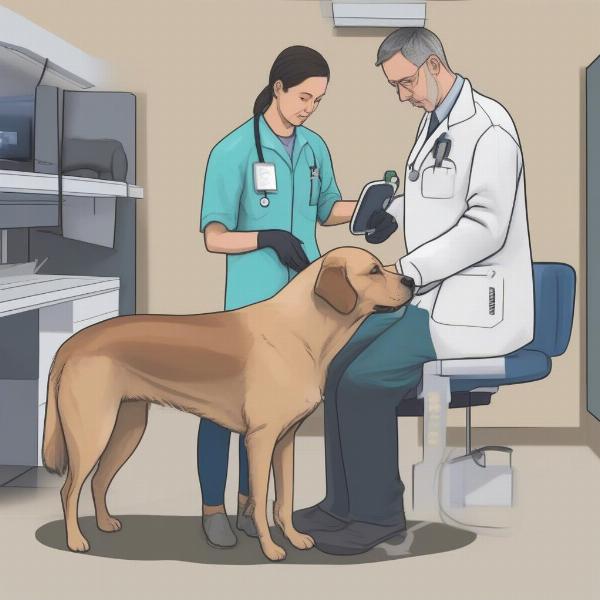A chip reader for dogs is a crucial tool for pet owners, veterinarians, and animal shelters. It allows for quick and reliable identification of microchipped dogs, which can be invaluable in reuniting lost pets with their families, providing necessary medical information, and managing animal populations. This article will explore everything you need to know about chip readers for dogs, from how they work to the different types available and their importance in responsible pet ownership.
How Do Chip Readers for Dogs Work?
Chip readers, also known as microchip scanners, use radio frequency identification (RFID) technology. They emit a low-frequency radio wave that activates the microchip implanted under your dog’s skin. The activated microchip then transmits its unique identification number back to the scanner, which displays it on the screen. This number can then be used to access the pet’s information in a microchip registry database.
 Scanning a Dog with a Microchip Reader
Scanning a Dog with a Microchip Reader
Different Types of Chip Readers for Dogs
Several types of chip readers are available on the market, catering to various needs and budgets.
Universal Chip Readers
These scanners are designed to read microchips from different manufacturers, making them ideal for animal shelters and veterinary clinics that encounter animals with various types of microchips.
Handheld Chip Readers
Portable and convenient, these are popular among animal control officers and pet owners who want a readily available way to check for microchips.
Bluetooth Chip Readers
These newer models connect to smartphones or tablets via Bluetooth, allowing for easy data transfer and access to microchip databases. Some even offer GPS tracking capabilities.
Why is a Chip Reader Important?
A chip reader plays a vital role in numerous situations:
- Reuniting Lost Pets: Quickly identifying a lost dog’s microchip significantly increases the chances of a happy reunion with its owner.
- Veterinary Care: Access to medical history through the microchip can be critical in emergencies.
- Shelter Management: Chip readers help shelters efficiently track and manage their animal populations, ensuring proper identification and reducing the risk of misidentification.
- Proof of Ownership: Microchips provide definitive proof of ownership, which can be crucial in disputes or legal situations.
Choosing the Right Chip Reader for You
Choosing the right chip reader depends on your specific needs. Consider factors such as frequency of use, budget, and desired features like Bluetooth connectivity and GPS tracking.
What to Do if You Find a Lost Dog
If you find a lost dog, take it to your nearest veterinarian or animal shelter to have it scanned for a microchip. They can use a chip reader to access the dog’s information and hopefully reunite it with its worried owner.
Conclusion
Chip readers for dogs are essential tools for responsible pet ownership and contribute significantly to animal welfare. By understanding the technology and its benefits, you can make informed decisions about your pet’s safety and contribute to a more effective system for reuniting lost pets with their families. Remember, microchipping your dog and having access to a chip reader can make all the difference in bringing a lost pet home.
FAQ
- How much does a chip reader for dogs cost? Prices vary depending on the type and features, ranging from affordable handheld models to more advanced Bluetooth-enabled options.
- Where can I buy a chip reader for dogs? Chip readers are available online, at pet supply stores, and through some veterinary clinics.
- Are all chip readers universal? No, not all chip readers are universal. It’s important to choose a universal scanner if you anticipate encountering chips from different manufacturers.
- Is microchipping painful for dogs? Microchipping is a quick and relatively painless procedure, similar to a routine vaccination.
- How do I register my dog’s microchip? You’ll need to register your dog’s microchip with a reputable registry database, providing your contact information and your dog’s details.
- Can a microchip be removed from a dog? While possible, microchip removal requires a surgical procedure.
- How long does a microchip last? Microchips are designed to last a lifetime.
dog flap microchip
dog tag with qr code
heavy duty dog door
qr code dog tag
ILM Dog is your trusted international resource for dog care and upbringing. We offer expert guidance on breeds, health, training, nutrition, grooming, and much more. From puppy care to senior dog support, we provide valuable, practical advice for dog owners worldwide. Contact us at [email protected] or +44 20-3965-8624. Visit ILM Dog for more information on all aspects of dog care.